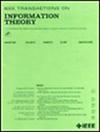DNA存储中有限概率误差的编码
IF 2.2
3区 计算机科学
Q3 COMPUTER SCIENCE, INFORMATION SYSTEMS
引用次数: 0
摘要
DNA具有高密度、耐用性和可复制性等显著特性,是最具吸引力的存储介质之一。新兴的DNA存储技术使用复合DNA字母,其中信息由概率向量表示,导致比常规DNA字母更高的信息密度和更低的合成成本。然而,它也面临着不可避免的噪声和信息腐败问题。本文探讨了基于DNA的存储系统中复合DNA字母的通道,并引入了概率向量上有限大小概率误差的分组编码。首先,给出了有限量级概率纠错码的外边界和内边界。此外,还提出了错误数以t为界,错误大小以l为界,概率分辨率固定为k的代码结构。这些结构侧重于利用基于dna的存储系统中有限大小概率错误的特性,从而提高了复杂性和冗余度方面的性能。此外,还建立了其中一个结构的渐近最优性。最后,提出了基于其中一种结构的系统代码,为实际实现提供了有效的信息提取。本文章由计算机程序翻译,如有差异,请以英文原文为准。
Codes for Limited-Magnitude Probability Error in DNA Storage
DNA, with remarkable properties of high density, durability, and replicability, is one of the most appealing storage media. Emerging DNA storage technologies use composite DNA letters, where information is represented by probability vectors, leading to higher information density and lower synthesizing costs than regular DNA letters. However, it faces the problem of inevitable noise and information corruption. This paper explores the channel of composite DNA letters in DNA-based storage systems and introduces block codes for limited-magnitude probability errors on probability vectors. First, outer and inner bounds for limited-magnitude probability error correction codes are provided. Moreover, code constructions are proposed where the number of errors is bounded by t, the error magnitudes are bounded by l, and the probability resolution is fixed as k. These constructions focus on leveraging the properties of limited-magnitude probability errors in DNA-based storage systems, leading to improved performance in terms of complexity and redundancy. In addition, the asymptotic optimality for one of the proposed constructions is established. Finally, systematic codes based on one of the proposed constructions are presented, which enable efficient information extraction for practical implementation.
求助全文
通过发布文献求助,成功后即可免费获取论文全文。
去求助
来源期刊

IEEE Transactions on Information Theory
工程技术-工程:电子与电气
CiteScore
5.70
自引率
20.00%
发文量
514
审稿时长
12 months
期刊介绍:
The IEEE Transactions on Information Theory is a journal that publishes theoretical and experimental papers concerned with the transmission, processing, and utilization of information. The boundaries of acceptable subject matter are intentionally not sharply delimited. Rather, it is hoped that as the focus of research activity changes, a flexible policy will permit this Transactions to follow suit. Current appropriate topics are best reflected by recent Tables of Contents; they are summarized in the titles of editorial areas that appear on the inside front cover.
 求助内容:
求助内容: 应助结果提醒方式:
应助结果提醒方式:


